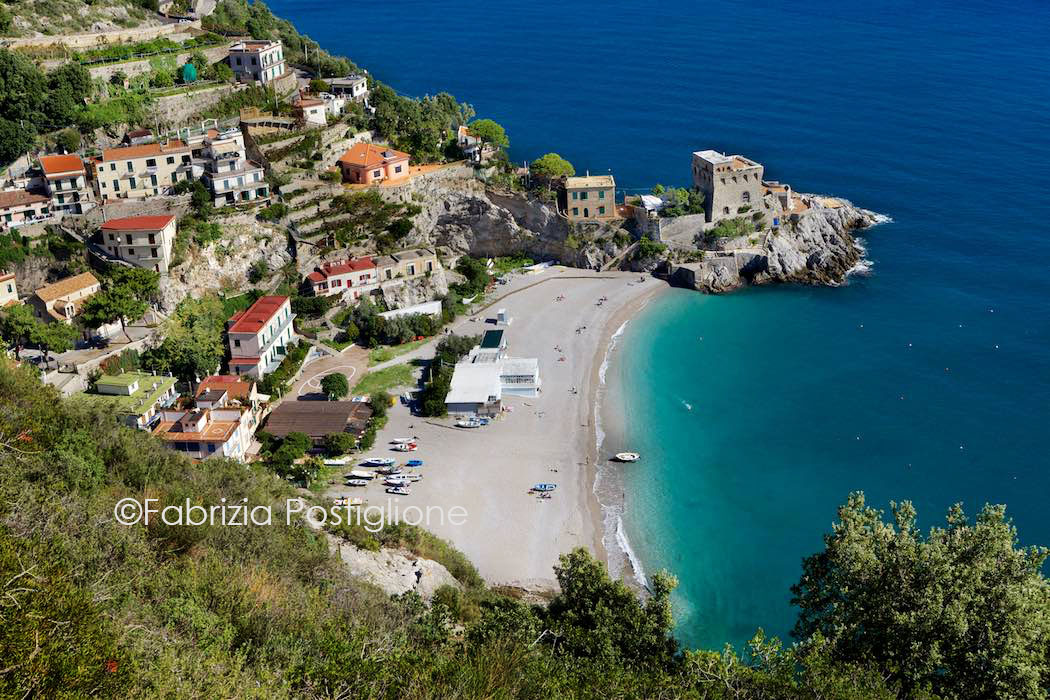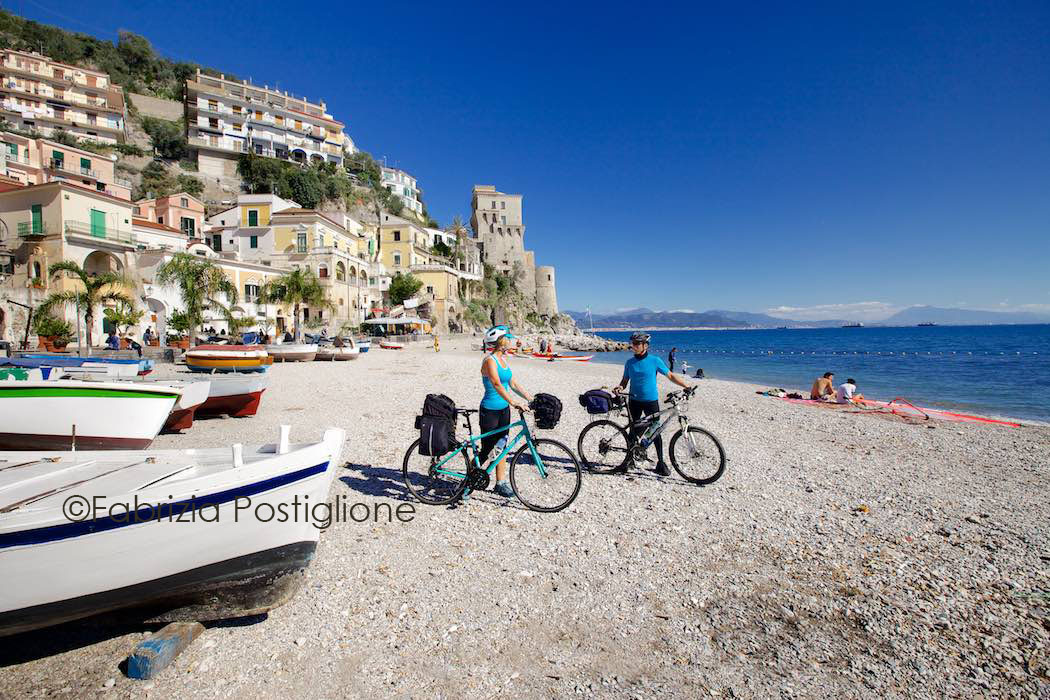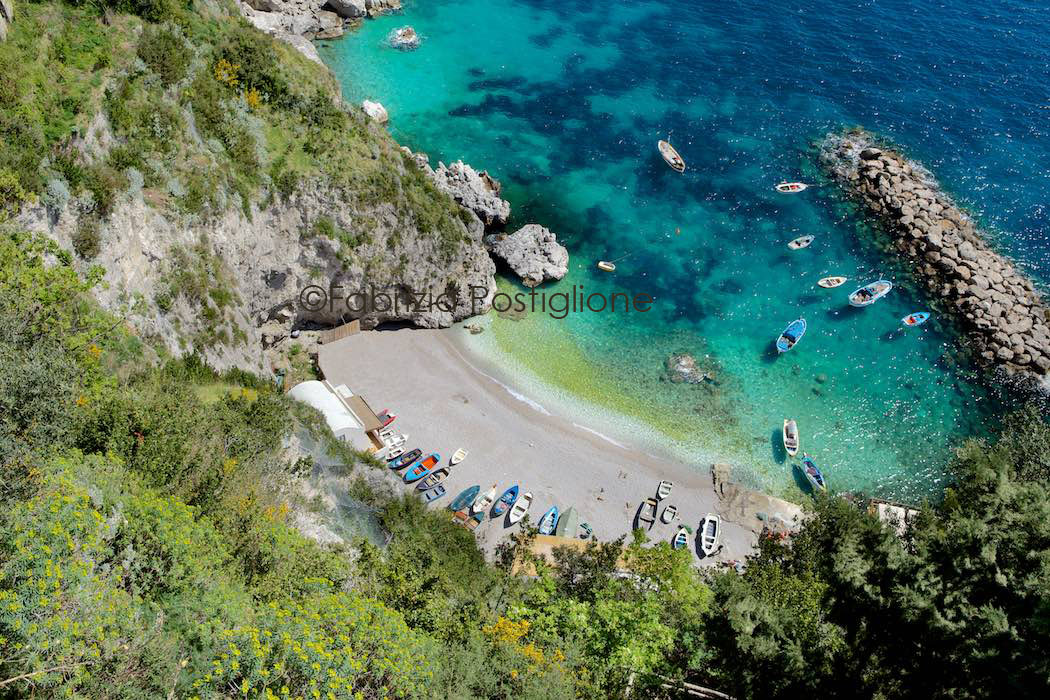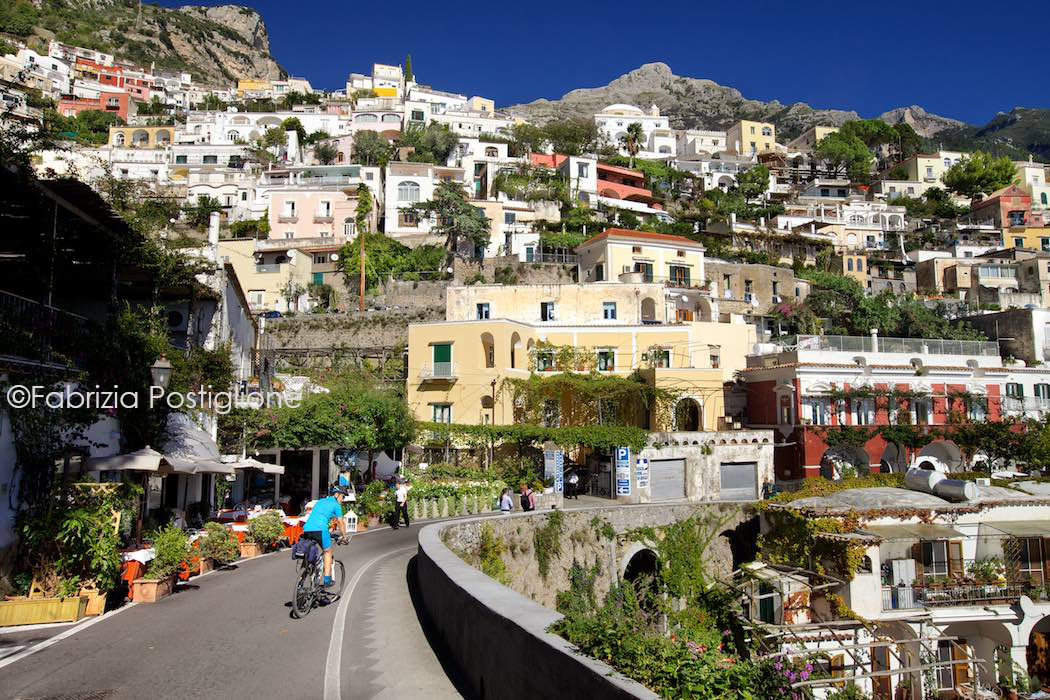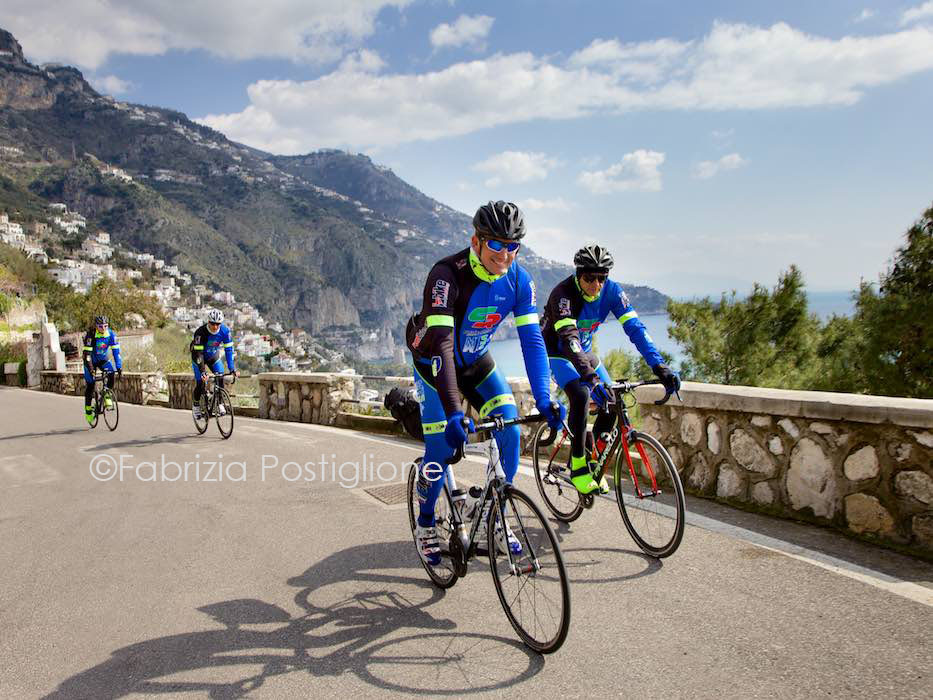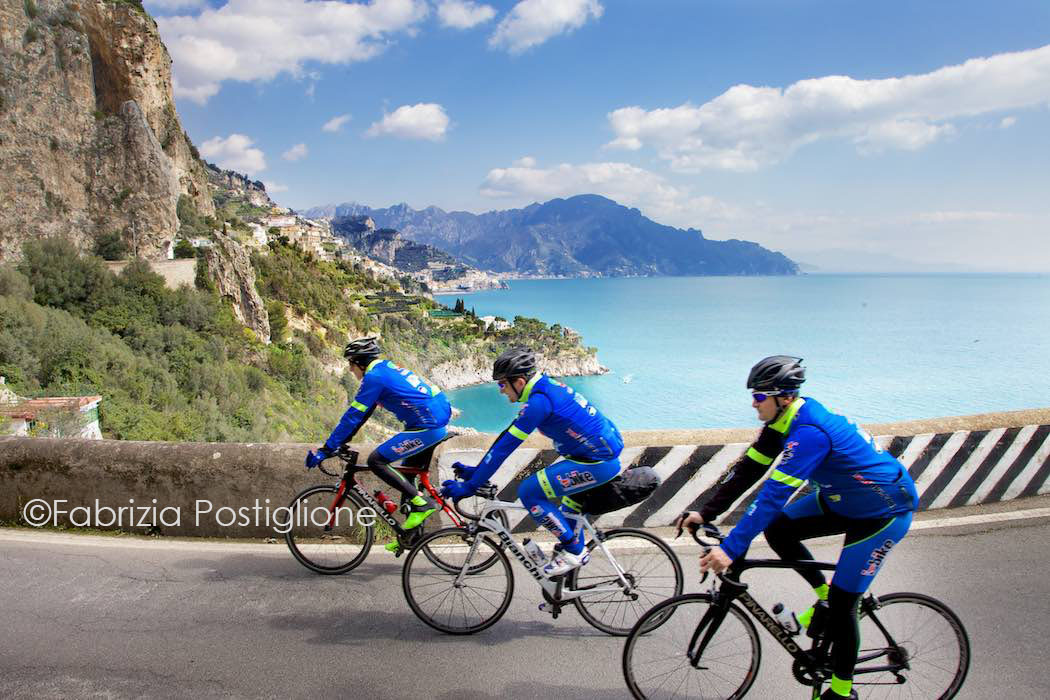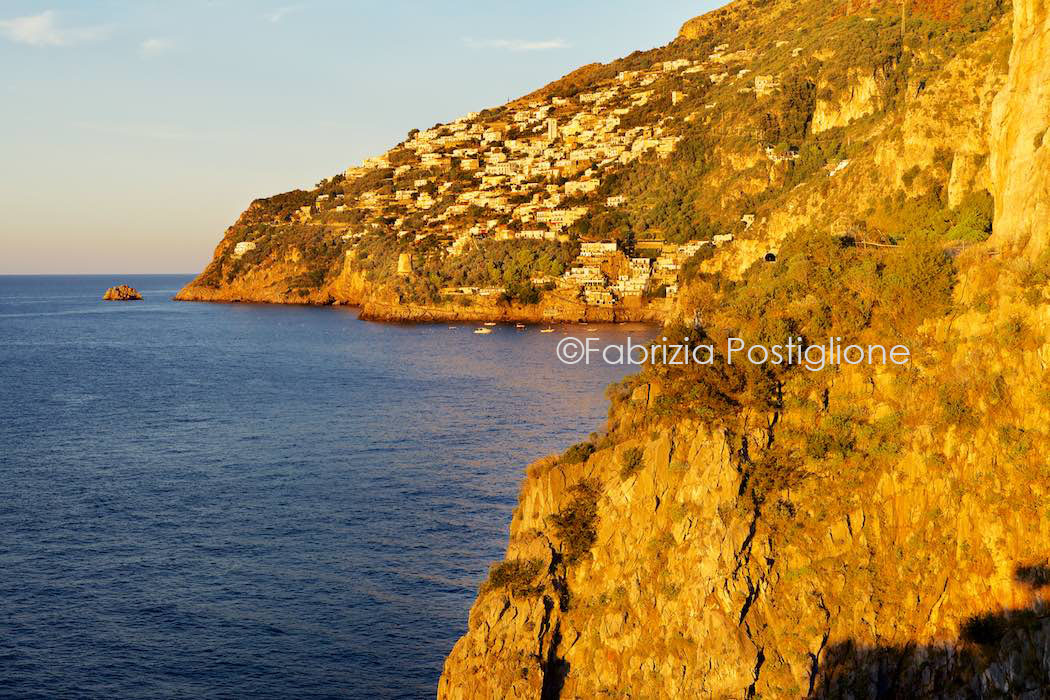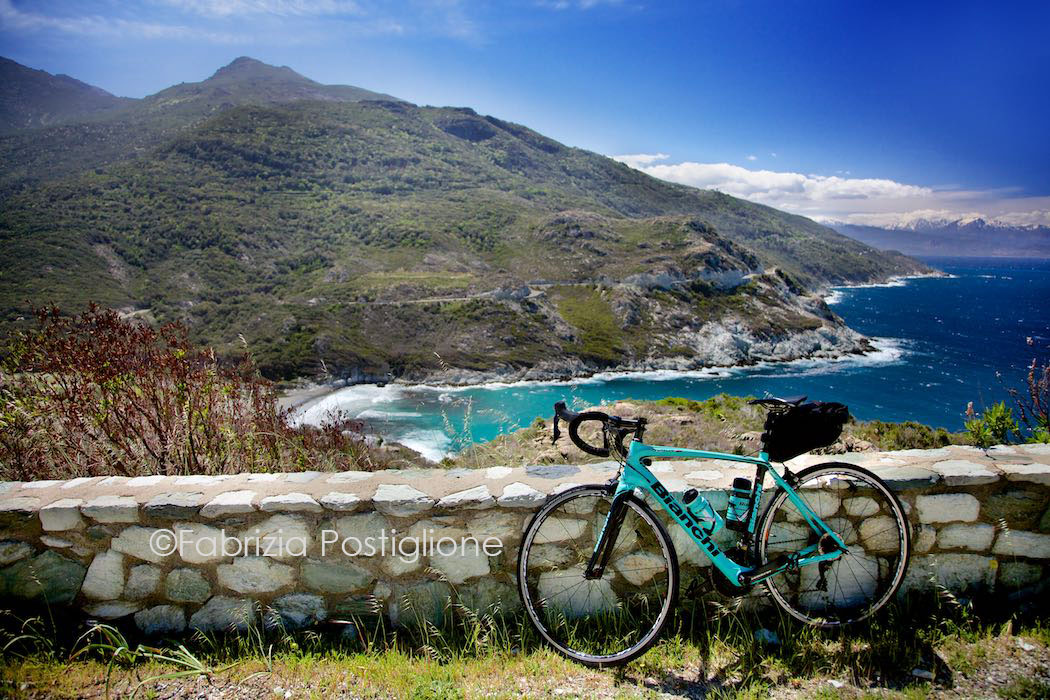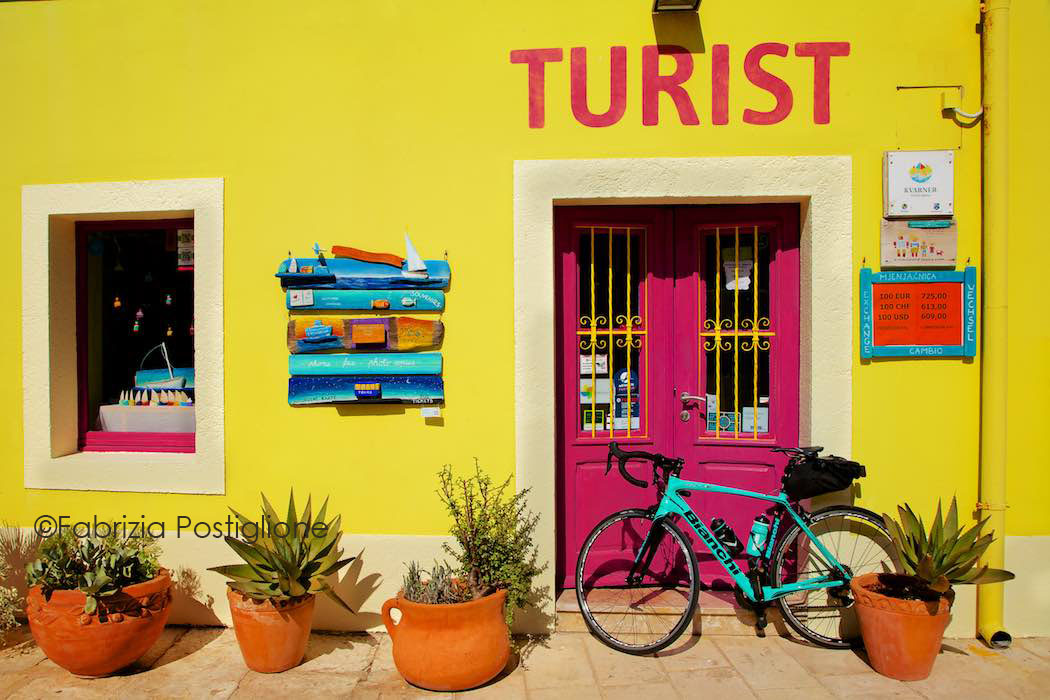IN BRIEF
Stages: 1
Distance: 38,5 km one-way
Elevation gain: 550 m
Elevation loss: 590 m
Traveling time: about 3 hours (without stops)
Difficulty level: medium
GPS file:
Below, at the end of the main article, you can see more details on the itinerary (with the GPS files “stage by stage”), the right bike and clothing, as well as advice on where to eat and sleep, what to visit, tourist offices, bike rental and guided tours, etc.
The Amalfi Coast unfolds under the cyclist’s eyes at a slow pace. You slide silently on those exciting curves, surprising yourself to admire glimpses often impossible to notice behind the wheel of a car. The metronome of the pedals courts the twist drawn by the road that almost always runs at high altitude, overlooking the blue. The SS163 state road (built by the Bourbons in 1850 to connect Positano to Vietri) looks like a “seam” that follows the draping of cliffs, coves, beaches, fjords, arches and rocks. In these natural scenes, the inhabitants have built, over the centuries, terraced vineyards, vegetable gardens and lemon groves (delimited by the geometries of the dry stone walls), and then pastel-colored villages: houses with dizzying terraces and barrel roofs, connected to each other by stairways, alleys and covered walkways. I believe this coast is enchanted because it is a love story between the sea and the mountain, between the rock and the wave. You have to experience it to understand what I mean.
If you ride early in the morning, or off-season on those blue-sky days of early November or February, the traffic is scarce and sometimes you can hear the mantra of the wave sensually massaging the rock, much further down. And the words of Astolphe de Custine, French traveler and writer of the nineteenth century, come to my mind: “In this incomprehensible landscape, only the sea is horizontal, and everything that is dry land is almost perpendicular”.
Only on the saddle of a bike can you really stop anywhere to look at (and photograph) the view: the road is narrow and cars cannot do that. It is also much easier to visit the historic centers and go to the beach, as the parking spaces are nowhere to be found or are very expensive. To go down to Positano, the glamorous queen of the Amalfi Coast and a holiday resort already in Roman times, I abandon the SS163, the corniche road that follows the coastline, and dive into the hairpin bends that zigzag until the beginning of the pedestrian zone, where I dismount my bike and continue on foot (the heart of the town is all on stairs and crowded alleys), being tempted by the “Positano fashion” boutique of Antica Sartoria by Giacomo Cinque where I try his joyful and colorful creations, dictated by an exuberant fantasy and handmade with applications of beads and embroidery: beach bags, sarongs and coordinated bikinis, straw hats, dresses, skirts and cover-ups in linen or cotton. A perfect look for a “glam” holiday. I get back into my cycling kit and continue my exploration walking down along Via dei Mulini.
After Palazzo Murat, further down I admire the Church of Santa Maria Assunta, with the multicolor majolica dome of Vietri, that shines with its yellows, greens, blues, reds. The history of the Positano cathedral is linked to that of a 10th century Benedictine monastery, but in its present form the construction dates back to the renovations carried out between 1777 and 1782. It has classic interiors, with golden Ionic capitals and cherubs. In addition to the bust of the patron San Vito, it houses a highly venerated Byzantine icon of the Holy Mary. Under the church grounds a maritime villa from the 1st century AD was found, which survived the eruption of Vesuvius in 79. Some frescoes are well preserved and depict (in bright tones of green, yellow, lapislazuli blue) peacocks, sea monsters, dolphins, swans, cupids, seahorses. The site, with its findings, has been restored and converted into an exhibition space, now called “Museo Archeologico Romano” (MAR) of Positano. It is beautiful and not to be missed out.
From the opposite Piazza Flavio Gioia square, embellished with the mosaics of contemporary artist Mimmo Palladino, I then descend towards the Spiaggia Grande beach, from which I can embrace the classic “postcard” of the Pyramid: the conglomerate of colorful houses (a mix of Moorish-Byzantine architecture and eighteenth-century buildings) that cover the hill and climb to the sky.
To reach the Fornillo beach, I take Via Positanesi d’America, which runs alongside the rock west of the bay and is delimited by two 16th century anti-Saracen structures: the Clavel Tower and the Trasita Tower.
Offshore I can see Li Galli, the three islets that, according to legend, were the “lair” of the Sirens. As a passionate former ballerina, I remember that in recent historical times Li Galli islets were celebrity dancer Nureiev’s buen retiro. After his death they were sold to another private owner and now some of the residences can be hired for vacationing or private events. Now it is time to get back in the saddle: I return to the upper side of the village, exit the pedestrian area and can restart riding from Via Cristoforo Colombo. After the famous Hotel Sirenuse, I stop to immortalize a fantastic shot of the village. Flowing on the SS163 Amalfi road, I ride east, still in a very developed area, towards the hamlet of Arienzo. The asphalt strip still wedges, with deep curves, in some very green valleys. After having “flown” over Laurito Beach, I approach the magnificent ridge where Vettica Maggiore stands. Vettica is a hamlet of Praiano’s. Loved by the Doges of Amalfi (who chose it as a summer residence) and by the American artist Sol Lewitt (1928-2007), but less social than Positano, the village of Praiano has recently become an open-air museum thanks to the Naturarte project, a series of art installations by some of the best artists in the area. The artists were asked to distribute along the most popular pedestrian sections a set of works related to culture, traditions and local mythology, conceived in a way to dialogue with the natural environment that hosts them without in any way upsetting it but rather enriching it in harmonious way.
Seven of these paths have ceramic installations. The eighth, which leads from the town to the Convent of Santa Maria a Castro (San Domenico) along the side of the mountain, being entirely rocky, has stone works. The urban nucleus of Praiano, made up of white houses scattered on the ridge of Monte Sant’Angelo, is a hundred meters above the sea. You can go up and down guts and steps, starting from the Renaissance Church of San Gennaro down to Cala Gavitella, ideal for a dip at sunset. After passing Praiano, I pedal on a serpentine that narrows and gets nervous, and makes a very deep curve at the junction for Marina di Praia, where it is possible to ride to the pebble beach. The road then overcomes, on a viaduct, a clean cut in the Lattari Mountains: the Fjord of Furore. In medieval times the micro village was a navel of maritime trade, thanks to the stream that made the mills and the paper mill run. I go through a tunnel and then start to climb again. The Amalfi Coast is a relentless rollercoaster, a vertical territory with very little flat terrain!
A few kilometers further I pass a kiosk of Sfusato d’Amalfi lemons (the lemons used to prepare limoncello) and irreverent chili peppers (dubbed “Natural Viagra”), then arrive above Conca dei Marini, a tiny village whose buildings emerge from the sapphire water. The nearby beaches of sand and white pebbles can only be reached by boat or walking long stairways or paths and are lapped by emerald waves.
I continue to ride enjoying the magnificent vistas, totally lost in the great beauty of Nature. After the bend overlooking Santa Croce bay, the SS 163 finally begins to descend towards Amalfi, offering beautiful views over the city that gives the coast its name.
Part of the original city of Amalfi was engulfed by the waves in the earthquake of 1343, but, despite the tourist chaos in the high season being “unmoving”, I cannot but be astonished in front of the urban agglomeration of the oldest and, for two centuries, the most powerful among the medieval Maritime Republics, which flows from the Valle dei Mulini valley and is draped on the sides of the inlet. A Saracen tower appears in the east, near the Convent of San Francesco. The main beach has inviting turquoise waters and is easily accessible with the bike.
Amalfi has a history of technical progress in naval matters (Flavio Gioia was credited with inventing the compass), merchant exchanges and paper production. In the nineteenth century the travelers of the Gran Tour fell in love with it, due to the climate (still very pleasant!), the lush lemon groves and the arabesque architecture, wrapped around each other and pierced by covered walkways which then change into stairs and alleys. Due to the crowds, I dismount the bike to visit Piazza del Duomo square, the heart of the city, which is surmounted by the steps of the Arab-Byzantine-style religious monumental complex, famous for its golden façade, that shines in the afternoon light, and the beautiful cloister.
After Flavio Gioia’s square I face another steep climb, which allows me to go over the promontory. Then Atrani, the “muse of Escher”, appears. For his paintings with ambiguous perspectives, the Dutch artist was inspired by this microscopic village gathered around the delightful Piazza Umberto I square, separated from the beach by the arches that support the coast road. The asphalt strip rears up towards Castiglione (the beach of Ravello) giving me a hard time for a few seconds (the gradient is over 10%). I cross the hamlets of Cosma and Marmorata, a few kilometers of very developed coastline full of B&B’s, villas, guesthouses and vacation homes. Then I eventually descend to Minori, a more subdued seaside resort, already known in the Middle Ages for its production of pasta. I pedal along the tree-lined promenade that borders the small sandy beach and stop at De Riso Pastry Shop to eat the famous Delizia al limone, a dessert made of sponge cake and lemon chantilly cream. Super! After testing my legs with another climb to overcome the promontory that separates Minori from Maiori, the SS163 sinks into the largest valley of the coast, guarded by the fortress of San Nicola de Thoro-Plano. I appreciate the long flat straight of the Maiori waterfront, which was the main port of the Amalfi Republic. Thanks to the wealth of convents and noble palaces, King Philip IV declared it a Royal City. Today, however, it has less charm than the other villages, because the building speculation following the 1954 flood (which wiped out much of the historic center) has left its mark. I refill the bottle at the fountain in Corso Regina and take an energy gel: I know that after Maiori, I have a long climb to reach Capo d’Orso. Past the deep inlet of Salicerchie, I ride my bike in a splendid and wild area, poised between the clouds and the waves. By devouring curve by curve, under the sun that scalds my skin, I abandon myself to the dizzying beauty of this vertical territory, which defies gravity and imposes a certain physical effort on those who really want to know it.
If I stop to look west, the peninsula appears as a mythological animal lying in the deep blue sea. Lapped by fantastic turquoise waters, the Dead Horse Beach looks inviting, but is only accessible by sea. After many kilometers of ascent and solitude, I reach Capo d’Orso. Here the fun begins: I start descending along a series of bends overlooking the sea, the city of Salerno and, further on, the Cilento coastline. Erchie is a pleasant mirage: from the cliff I can see a crib of pastel houses, cut into the waves and guarded by the medieval tower. The bay of pebbles and sand, reachable by bike via a road on the right, is one of the most peaceful and suggestive of the Amalfi Coast, ideal for swimming in the azure blue water. I don’t miss this opportunity and soon reach the village to spend some time resting in the sun.
After the steep climb to return on the main road, I ride on a gentle descent towards Cetara. This village, which appears guarded by a large tower, holds a fleet of fishing boats to catch the tuna on the high seas. Many colorful goiters “doze” on the beach: at night, with the lampare (fishing lights) the fishermen go out to catch the anchovies to make the colatura, a tasty sauce similar to the Roman garum, omnipresent in the exquisite local cuisine based on blue fish. The SS163 coastal road continues to snake for about 5 km, now on very gentle slopes, towards Vietri sul Mare, the capital of Campania ceramics. I see Vietri with its large sandy beach and the usual technicolor houses set on the hill. In the city the street art is expressed in panels of majolica with the colors of the Mediterranean. In addition to rummaging through the many pottery shops, you can visit the church of San Giovanni Battista and the Ceramics Museum in Raito, a hamlet above Vietri. My cycle tour ends on the immense beach of the town, where the rough “vertical” sweetness of the Amalfi Coast finally surrenders to the plain.
PRACTICAL TIPS
The right bike
The route is on asphalt: in some places it is new and very smooth, in other places a bit damaged. A racing bike or a touring bike will be fine. The itinerary is a rollercoaster, but (except for the Castiglione climb, after Atrani, that reaches a 10% gradient) the climbs are never too steep, averaging 4% – 5% (sometimes 6% to 7%).
Anyway, an e-bike is a must for the less trained.
Good to Know
Italian motorists are unruly and tend to drive too fast. In order not to go unnoticed, install intermittent front and rear lights, also visible during the day, because there are a few short tunnels along the way, too. The reason why the Amalfi Coast is one of the most beautiful places for road cycling in Italy is that it’s a scenic coastal ride with beautiful vistas, you have the possibility of refreshing stops in clear waters and to do pleasant visits to the villages. But beware the traffic: if you can, choose the off-season months (October to March) or ride early in the morning. In the summer another time with little traffic is lunch (roughly between 1pm and 4pm) when everyone is on the beach. In autumn, late afternoon is also fine. In any case, always avoid Sundays (too many motorcyclists). Even in January you can find mild temperature and sunshine days, but the best months, climate wise, are April/May and October. It’s not necessary to load yourself with food or water: you find lots of bars or supermarkets along the way. You can refill your bottle at the fountain in Corso Regina in Maiori, too. In the warmer months it is useful to carry a swimsuit and a pareo or a towel, to be able to take a refreshing dip in the crystal clear waters. The one-way route is 38,5 km long and you’ll take about 3 hours to complete it (without the stops). If you want to return to Positano, plan to be out riding the entire day.
Guided Tour & Bike Rent
I Rent Bike-Italy Bike Experience (irentbike.it, tel. 3774975416) is an operator specialized in bicycle touring in Southern Italy and the Dolomites.
It has a large portfolio of excellent quality bicycles for all needs: from carbon racing bikes to MTB, trekking and e-bikes. Contact the very experienced Mr. Salvatore D’Aniello for tailor made guided tours. Day trips usually start from 85 € per person for groups of 3-4 to 15 persons and include a trekking bike, a helmet and the bike guide.
WHERE TO STAY
POSITANO
La Bougainville ***
Delightful boutique hotel in the alleys of the historic center of Positano, a short distance from the beach. Pastel-colored rooms furnished with contemporary taste.
Positano, Via C. Colombo 25, tel. 0039 089 875047, bougainville.it.
FURORE
Locanda Del Fiordo
Very romantic B&B, it has rooms carved into the rock, with Vietri majolica tiles, wrought iron beds, panoramic flowered terraces overlooking the blue. The private access to the sea allows diving without crowds even in August. In the bar-restaurant you can taste local fish dishes and the delicious Caprese salad with Agerola fiordilatte and tomatoes grown in their garden. Excellent value for money. The owners are very friendly and you can store the bike there without problems.
Fiordo di Furore, Via Trasita 9, tel. 0039 089874813, locandadelfiordo.it.
VIETRI SUL MARE
Paradiso Relais *****
Small atmospheric hotel, ideal for a romantic getaway. Modern minimal chic suites, with jacuzzi on the terrace. Small outdoor swimming pool on a panoramic solarium terrace. Guests can use the Hotel Raito’s ExPure Spa, a few dozen meters away, or book wellness treatments in the room. Raito (Vietri sul Mare), Via Nuova Raito 10, tel. 0039 0897632301, relaisparadiso.it
WHERE TO EAT
AMALFI
Marina Grande
Gourmet restaurant, lounge bar and elegant beach club. On the terrace on the main beach Gianpaolo Esposito serves excellent sea and land cuisine, based on creativity and precious ingredients. Among the summer dishes to try: Wholemeal linguine, anchovies, colatura (fish sauce), spicy bread, sweet garlic sauce; Low temperature cooked cod, garden veggies and curly scarola; Eliche, scampi, smoked eggplant, burrata.
Amalfi, Viale della Regione 4, tel. 0039 089871129, ristorantemarinagrande.com. Average bill: 50 €.
CETARA
Acqua Pazza
On the Cetara waterfront, this restaurant serves only fresh seasonal fish. From the tradition of smoked tuna and swordfish or steamed whitebait with parsley, to the refined and delicate surprise of the ziti (a kind of pasta) with tuna chops or the tuna and fig bottarga, up to the characteristic anchovy sauce for a first course of linguine. Cetara, Corso Garibaldi 38, tel. 0039 089 26 16 06, acquapazza.it. Average bill: 40 €.
PRAIANO
Locanda Costa Diva
The tables are immersed in the citrus groves overlooking the sea. Elio Milo serves traditional recipes based on vegetables from his garden and local fish, such as Pezzogna in lemon leaves. The inn also has beautiful rooms with panoramic terraces. Praiano, Via Roma, tel. 0039 089 813076,locandacostadiva.it. Average bill: 35 €.
POSITANO
Buca di Bacco
Fish specialties to be enjoyed in a veranda overlooking the Spiaggia Grande Beach: impepata of mussels, spaghetti with veracious clams, fried anchovies, poached octopus cooked in the crock.
Positano, via Rampa Teglia 4, Tel. 0039 089875699; bucadibacco.it. Average bill: 50 €.
MINORI
Pasticceria De Riso
The exquisite sweets, ice creams, liqueurs, preserves of Sal De Riso based on top ingredients, such as the Sfusato Amalfitano lemon, the Giffoni hazelnuts, the annurche apples (a local variety), the Scala chestnuts, the highest quality chocolate. It is the best pastry shop on the Amalfi Coast. Do not miss the delicious Delizia al Limone (“lemon delight”).
Address: Via Roma 80, Minori (SA | Tel. 089877941 | Web: salderiso.it.
SHOPPING
Antica Sartoria
A cult address for the cheerful “Positano fashion”. The creations of the designer Giacomo Cinque are also worn by the divas passing through the Amalfi Coast. From ethnic-inspired tunics to sarongs coordinated with bikinis, then trousers and skirts in linen, silk and gauze, with applications of rhinestones, beads or embroidery, to be combined with straw or cloth bags and hats.
Positano, Via del Brigantino 9 (Spiaggia Grande), Tel. 0039 089 8123126; anticasartoriapositano.it.
WHAT TO VISIT
Monumental Complex of Amalfi Cathedral and Diocesan Museum
The complex includes the splendid Cloister Paradise, the Treasure Museum, the crypt with the relics of Saint Andrew the Apostle and the Cathedral.
Amalfi, Piazza Duomo, Tel. 0039 089 871324; museodiocesanoamalfi.it
Museo Archeologico Romano MAR
The beautiful Roman Villa, discovered underneath the oratory of the Maria Assunta Church, is a tangible proof that Positano has always been a privileged place of otium. This domus is of extraordinary scientific importance with its triclinium, its mosaic floor and wall paintings of the IV Pompeian style.
Positano, Piazza Flavio Gioia 7, tel. 00 39 331 208 5821 (WhatsApp Number); marpositano.it.
Museo della Ceramica Vietrese
The museum itinerary is divided into three sections organized according to a chronological and thematic principle. The first section, which displays works dating back to the 17th – 18th century, includes religious and devotional objects; the second houses objects such as everyday pottery dating, for the most part, in the 19th century; the third illustrates the so-called “German period” of Vietri ceramics, when the city became a destination for German ceramic artists. A specific space is destined for the facing tile, the so-called Vietrese riggiola.
Villa Guariglia, via Nuova Raito, Vietri sul Mare (località Raito), Tel. 0039 089211835.
TOURIST OFFICES
Azienda Autonoma Soggiorno e Turismo di Amalfi
Via delle Repubbliche Marinare 27, Tel. 0039 089 871107; amalfitouristoffice.it.
Azienda Autonoma di Soggiorno e Turismo di Positano
Via Guglielmo Marconi 288, Tel. 0039 089 875067
Ufficio Informazioni Turistiche di Praiano
Via G. Capriglione 116b, Tel. 0039 089 874557; praiano.org.
Pro Loco Vietri sul Mare
Via O. Costabile, 4 – Palazzo Della Guardia; prolocovietrisulmare.it.


